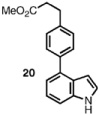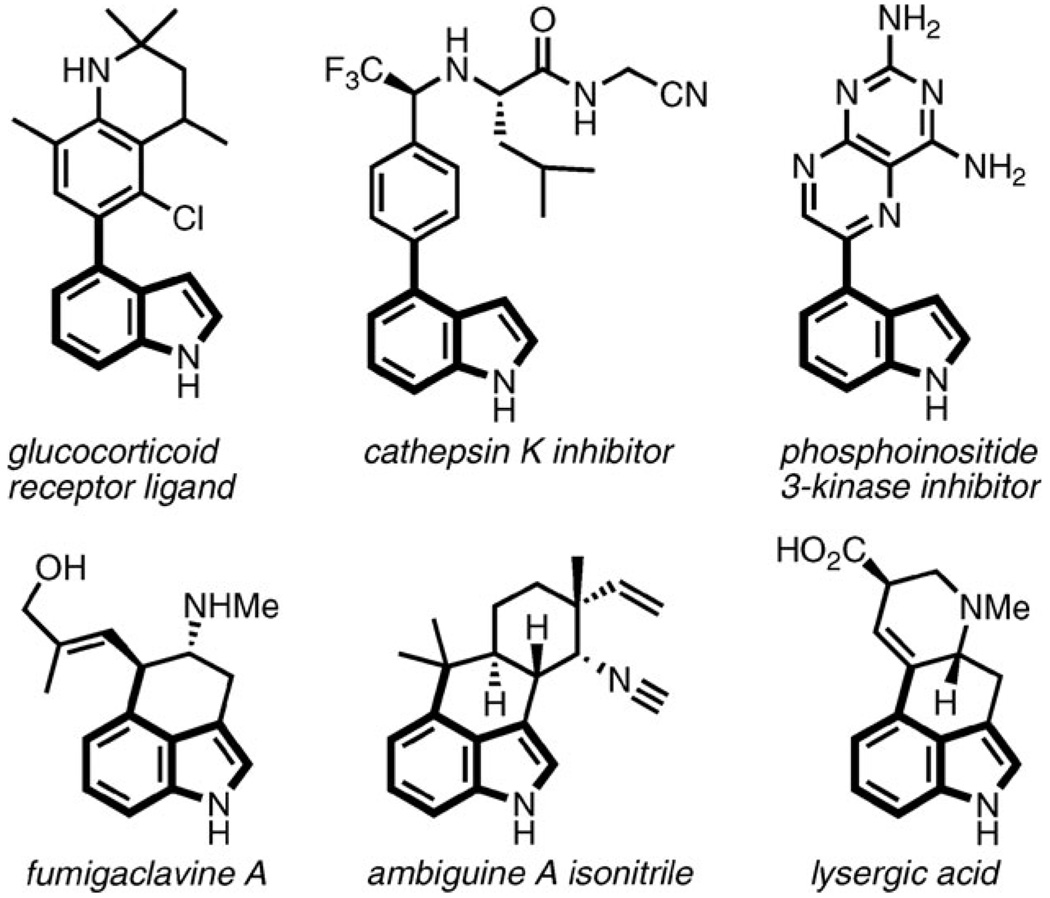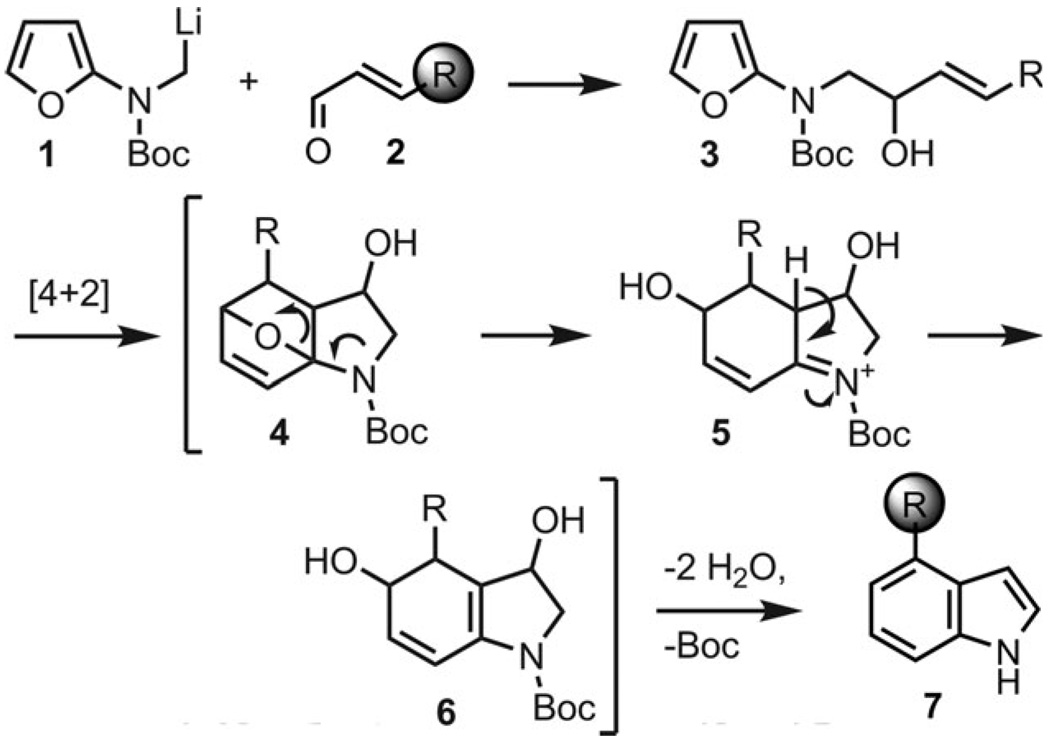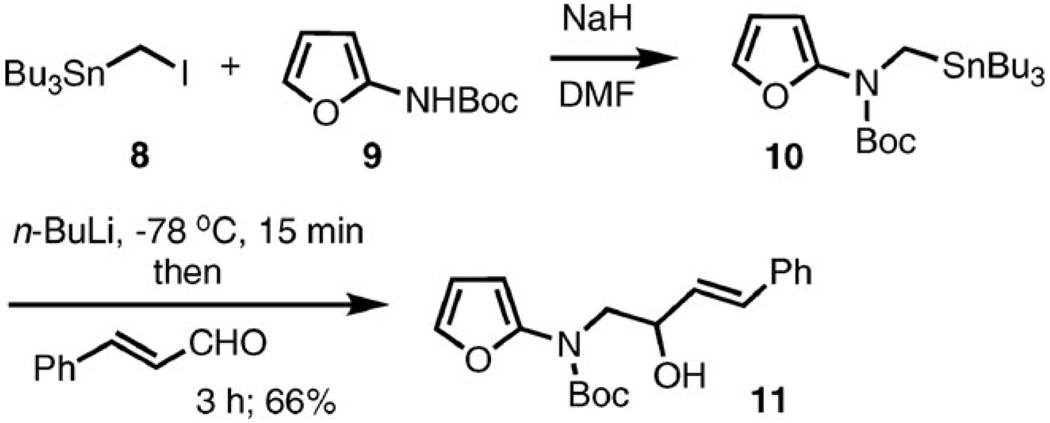Abstract
The key steps of a versatile new protocol for the convergent synthesis of 3,4-disubstituted indoles are the addition of an α-lithiated alkylaminofuran to a carbonyl compound, a microwave-accelerated intramolecular Diels–Alder cycloaddition and an in situ double aromatization reaction.
The indole moiety is a ubiquitous structural motif that is found in a wide array of naturally occurring alkaloids and designed therapeutic agents. Interestingly, a relatively uniform fraction of ~4% of all pharmaceuticals, high-throughput screening samples, as well as natural products, contain an aromatic or partially saturated indole core (Fig. 1).1 Accordingly, the search for efficient protocols for the synthesis of substituted indoles has remained an important research topic for over a century.2 As part of a program aimed at the synthesis of Ergot alkaloids,3,4 we have investigated suitable methodologies for the late-stage introduction of a 4-substituted indole ring system. Padwa and co-workers have developed an intramolecular Diels–Alder furan cycloaddition reaction that provides substituted indolines from N-homoallylic 2-aminofurans.5,6 We envisioned that the addition of an α-lithiated alkylaminofuran, 1, to an α,β-unsaturated carbonyl compound, 2, followed by the in situ cycloaddition and dehydrative aromatization of 6, would allow an extension of this methodology to the direct preparation of 4-substituted indoles, 7 (Scheme 1).
Fig. 1.
Representative synthetic and natural products with 4-substituted indole scaffolds (outlined in bold).1
Scheme 1.
Proposed indole synthesis.
The preparation of lithium reagent 1 was accomplished by transmetalation of stannane 10 (Scheme 2), which was readily obtained from known iodide 87 and Boc-protected 2-aminofuran 98 in the presence of sodium hydride. We next explored conditions for the addition of 10 to α,β-unsaturated carbonyl compounds. Transmetalation with n-butyllithium in THF occurred only sluggishly at −100 °C, and decomposition was found to be the major pathway at 0 °C. However, at −78 °C, transmetalation was complete within 15 min, and upon treatment with an excess of cinnamaldehyde, the expected addition product, 11, was obtained in 66% yield.
Scheme 2.
The preparation of furanyl stannane 10, and a typical transmetalation and aldehyde addition reaction.
After establishing a viable route to homoallylic furanyl amines, we turned our attention to the intramolecular Diels–Alder cascade indole formation process. Initially, alcohol 11 was heated in toluene at reflux. After 48 h, gradual decomposition of the starting material was observed. In contrast, when 11 was heated in o-dichlorobenzene under microwave irradiation for 30 min at 170 °C, complete consumption of the starting material was observed, and 4-phenylindole (12) was isolated in 72% yield, presumably according to the mechanism shown in Scheme 1. Indeed, this process proceeded concomitantly with thermal Boc deprotection.9 In an effort to shorten the reaction time, temperatures were varied, and optimal conditions were found to involve microwave heating of furan derivatives for 20 min at 180 °C. Under these conditions, 12 was obtained in 79% yield from 11 (Table 1, entry 1). The success of the microwave conditions vs. standard heating is likely to be a consequence of the much faster heating process and the higher temperatures in the pressurized reaction vial, which can easily be accomplished with current microwave reactors.
Table 1.
Scope of the microwave-accelerated intramolecular Diels–Alder indole formation cascade reaction
| Entry | Substrate | Time/min | Product | Yield (%) |
|---|---|---|---|---|
| 1 |  |
20 |  |
79 |
| 2 |  |
20 |  |
76 |
| 3 |  |
20 |  |
83 |
| 4 |  |
20 |  |
69 |
| 5 |  |
20 |  |
77 |
| 6 |  |
20 |  |
81 |
| 7 |  |
20 |  |
71 |
| 8 |  |
20 |  |
61 (7 : 4) |
| 9 |  |
25 |  |
69 |
| 10 |  |
30 |  |
48 |
| 11 |  |
30 |  |
36 |
| 12 |  |
30 |  |
84 |
This annulation strategy is quite tolerant of functional groups. Initially, we varied the 4-aryl substituents from simple electron-rich (entries 2 and 4) to electron-deficient arenas (entry 3), observing a slight increase in yield to 83% in the case of the 4-fluoro aryl substituent. Para- and meta-substituted arenes with ester-functionalized side chains behaved analogously to the methyl group (entries 5 and 6). The use of a tosyl-protected indole ring in substrate 23 provided the corresponding 3,4′-bisindole 24 (entry 7).
When symmetric bisfuran 25 was subjected to the Diels–Alder cascade process, diannulated products 26 and 27 were obtained exclusively in a 7 : 4 ratio, with no monocyclization being observed (entry 8). Interestingly, in this case, the major product still contained a single Boc protecting group. The formation of a monoprotected derivative of an otherwise symmetrical bisindole could potentially be advantageous for selective functionalizations and desymmetrizations. Alternatively, re-subjecting this compound to thermal reaction conditions (microwave irradiation at 180 °C, 20 min) cleanly removed the residual Boc functionality to afford fully deprotected species 27 in 89% yield after chromatographic purification.
The introduction of alkenyl and alkyl groups in position 4 of the newly formed indole ring was also possible (entries 9–12). Propenyl derivative 29 was isolated in 69% yield in a 7 : 1 ratio of E : Z isomers, while the efficiency of the process was slightly reduced for cyclopropyl compound 31 (48% yield) and isopropyl indole 33 (36% yield). In spite of the lower yield observed for 31, the successful use of a cyclopropane-substituted compound in this reaction sequence is noteworthy.
We were also interested in expanding the scope of this reaction to 3,4-disubstituted indoles, derived analogously from additions of lithium reagent 1 to α,β-unsaturated ketones. Specifically, tert-alcohol 34 was obtained by the treatment of 1 with 5 equiv. of 2-cyclohexene-1-one. The exposure of 34 to the standard microwave conditions provided cyclohexane-annulated indole 35 in 84% yield. Tricycle 35 is representative of the core heterocycle of many Ergot alkaloids.
In conclusion, we have developed a new method for the convergent and rapid preparation of 4-monosubstituted and 3,4-disubstituted indoles featuring the microwave-assisted Diels–Alder cyclization of furans. The cascade process is quite tolerant of functional groups and associated substitution patterns. This strategy is a convenient alternative to the common transition metal-mediated coupling processes for the synthesis of these heterocycles.
Supplementary Material
Acknowledgments
This work has been supported by the NIH/NIGMS CMLD program (GM067082), and, in part, by Merck Research Laboratories.
Footnotes
Electronic supplementary information (ESI) available: Experimental procedures and full characterization of all the final products. See DOI: 10.1039/b816989f
Notes and references
- 1.(a) Roach SL, Higuchi RI, Adams ME, Liu Y, Karanewsky DS, Marschke KB, Mais DE, Miner JN, Zhi L. Bioorg. Med. Chem. Lett. 2008;18:3504. doi: 10.1016/j.bmcl.2008.05.029. [DOI] [PubMed] [Google Scholar]; (b) Li CS, Deschenes D, Desmarais S, Falgueyret J-P, Gauthier JY, Kimmel DB, Leger S, Masse F, McGrath ME, McKay DJ, Percival MD, Riendeau D, Rodan SB, Therien M, Truong V-L, Wesolowski G, Zamboni R, Black WC. Bioorg. Med. Chem. Lett. 2006;16:1985. doi: 10.1016/j.bmcl.2005.12.071. [DOI] [PubMed] [Google Scholar]; (c) Doukas J, Wrasidlo W, Noronha G, Dneprovskaia E, Fine R, Weis S, Hood J, DeMaria A, Soll R, Cheresh D. Proc. Natl. Acad. Sci. U. S. A. 2006;103:19866. doi: 10.1073/pnas.0606956103. [DOI] [PMC free article] [PubMed] [Google Scholar]; (d) Vinokurova NG, Boichenko DM, Baskunov BP, Zelenkova NF, Vepritskaya IG, Arinbasarov MU, Reshetilova TA. Appl. Biochem. Microbiol. 2001;37:184. [PubMed] [Google Scholar]; (e) Huber U, Moore RE, Patterson GML. J. Nat. Prod. 1998;61:1304. doi: 10.1021/np9801561. [DOI] [PubMed] [Google Scholar]; (f) Smith S, Timmis GM. Nature. 1934;133:579. [Google Scholar]
- 2.(a) Glennon RA. J. Med. Chem. 1987;30:1. doi: 10.1021/jm00384a001. [DOI] [PubMed] [Google Scholar]; (b) Hugel HM, Kennaway D. Org. Prep. Proced. Int. 1995;27:1. [Google Scholar]; (c) Lounasmaa M, Tolvanen A. Nat. Prod. Rep. 2000;17:175. doi: 10.1039/a809402k. [DOI] [PubMed] [Google Scholar]; (d) Somei M, Yamada F. Nat. Prod. Rep. 2004;21:278. doi: 10.1039/b212257j. [DOI] [PubMed] [Google Scholar]; (e) Kawasaki T, Higuchi K. Nat. Prod. Rep. 2005;22:761. doi: 10.1039/b502162f. [DOI] [PubMed] [Google Scholar]; (f) O’Connor SE, Maresh JJ. Nat. Prod. Rep. 2006;23:532. doi: 10.1039/b512615k. [DOI] [PubMed] [Google Scholar]
- 3.Schiff PL. Am. J. Pharm. Educ. 2006;70:98. doi: 10.5688/aj700598. [DOI] [PMC free article] [PubMed] [Google Scholar]
- 4.For our previous studies on indoline and isoindolinone synthesis using nucleophilic addition and radical annulation strategies, see: Wipf P, Kim Y. Tetrahedron Lett. 1992;33:5477. Pierce JG, Waller DL, Wipf P. J. Organomet. Chem. 2007;692:4618. doi: 10.1016/j.jorganchem.2007.05.035. Wipf P, Maciejewski JP. Org. Lett. 2008;10:4383. doi: 10.1021/ol801860s. Pierce JG, Kasi D, Fushimi M, Cuzzupe A, Wipf P. J. Org. Chem. 2008;73:7807. doi: 10.1021/jo801552j..
- 5.(a) Kappe CO, Murphree SS, Padwa A. Tetrahedron. 1997;53:14179. [Google Scholar]; (b) Padwa A, Brodney MA, Dimitro M. J. Org. Chem. 1998;63:5304. [Google Scholar]; (c) Padwa A, Brodney MA, Liu Liu, Satake K, Wu T. J. Org. Chem. 1999;64:3595. doi: 10.1021/jo982453g. [DOI] [PubMed] [Google Scholar]; (d) Padwa A, Brodney MA, Satake K, Straub CS. J. Org. Chem. 1999;64:4617. doi: 10.1021/jo982061+. [DOI] [PubMed] [Google Scholar]; (e) Padwa A, Brodney MA, Lynch SM. J. Org. Chem. 2001;66:1716. doi: 10.1021/jo0014109. [DOI] [PubMed] [Google Scholar]; (f) Bur SK, Lynch SM, Padwa A. Org. Lett. 2002;4:473. doi: 10.1021/ol016804g. [DOI] [PubMed] [Google Scholar]; (g) Ginn JD, Padwa A. Org. Lett. 2002;4:1515. doi: 10.1021/ol025746b. [DOI] [PubMed] [Google Scholar]; (h) Zhang H, Boonsombat J, Padwa A. Org. Lett. 2007;9:279. doi: 10.1021/ol062728b. [DOI] [PMC free article] [PubMed] [Google Scholar]
- 6.For other pertinent intramolecular furan Diels–Alder reactions, see: Klein LL. J. Org. Chem. 1985;50:1770. Jung ME, Gervay J. J. Am. Chem. Soc. 1989;111:5469..
- 7.Ahman J, Somfai P. Synth. Commun. 1994;24:117. [Google Scholar]
- 8.Padwa A, Brodney MA, Lynch SM. Org. Synth. 2002;78:202. [Google Scholar]
- 9.(a) Wasserman HH, Berger GD, Cho KR. Tetrahedron Lett. 1982;23:465. [Google Scholar]; (b) Wipf P, Furegati M. Org. Lett. 2006;8:1901. doi: 10.1021/ol060455e. [DOI] [PubMed] [Google Scholar]
Associated Data
This section collects any data citations, data availability statements, or supplementary materials included in this article.





